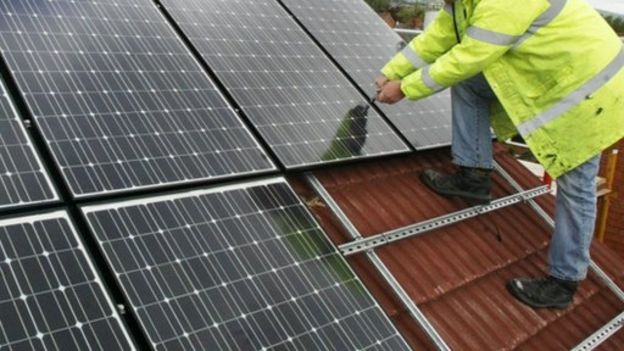With the increasing cost of climate change affecting business returns, sustainable plans are being propagated to reduce environmental impact. This article from Huffington Post relates how collaborations and Sustainable Development Goals can expedite transformations.
The world faces enormous human development and environmental challenges, from poverty and disease to food security and climate change. Significant progress has been made in the last two decades -- extreme poverty has halved, hunger has reduced and over two billion people have improved access to drinking water.
But huge problems remain. Inequality has widened, one in eight people still go to bed hungry and climate change threatens everything we have achieved since the 1960s. Half a century of progress stands to be wiped out within a generation.
For too long business has sat on the sidelines, either unable or unwilling to be part of the solution to these systemic challenges. But this is now rapidly changing as the limitations of governments and international bodies to resolve them become ever more apparent, as consumers increasingly are demanding change, and as the cost of inaction starts to exceed the cost of action.
The cost of climate change is already high and increasing. The UN Secretary General has calculated that, since 2000, economic losses from natural disasters total around $2.5 trillion. The OECD predicts that, by 2050, over $45 trillion of assets could be at risk of flooding. Accenture has found that significant supply chain disruptions can cut the share price of companies by 7 percent, whilst KPMG estimates that the total profit of the food industry is at risk by 2030.
We are seeing the effect of climate change in our own business. Shipping routes cancelled because of hurricanes in the Philippines. Factories closing because of extreme cold weather in the United States. Distribution networks in disarray because of floods in the UK. Reduced productivity on our tea plantations in Kenya because of weather changes linked to deforestation of the Mau forest. We estimate that geo-political and climate related factors cost Unilever currently up to €300 million a year. This not only impacts our shareholders but with over five million in our supply chain and more than two billion consumers around the world, the repercussions ripple much wider.
As tackling these issues becomes not just a moral but a commercial imperative, a growing number of businesses are stepping up to the plate. Today, three-quarters of the largest companies have set themselves clear social and environmental goals, 4,000 now report on CO2 emissions, and 50 of the top 200 have set an internal price for carbon.
The Unilever Sustainable Living Plan
Our own response is set out in the Unilever Sustainable Living Plan, which has set stretching goals to reduce our environmental footprint and increase our social impact as we grow our business. We are making progress. All of the electricity for our sites in North America and Europe now comes from certified, renewable sources. In absolute terms, CO2 emissions from energy in manufacturing are nearly a third below 2008 levels, water abstraction is down 29 percent and total waste sent for disposal is down two-thirds -- all achieved while increasing production volume. It is making us a more efficient organisation and saving us money -- over €300 million in cumulative avoided supply chain costs since 2008.
However, as combating climate change becomes more urgent, the time has come to look beyond incremental reductions in environmental impacts and increases in social impacts, important though these are. Business can and must make a bigger difference to global challenges by leveraging its scale, influence, expertise and resources to drive transformational change at a systemic level.
This is crucial because the economic system we all live and work within, drive our behaviours and choices, and without changing them we cannot hope to achieve the structural shifts that have to be made. Business is responsible for more than half the world's GDP, so unless we make change happen, we will not see the reduction in greenhouse gas emissions (GHG) the world needs.
The Better Growth, Better Climate Report, published in 2014 by the Global Commission on the Economy and Climate, of which I was a member, identified three key systems of the economy where there is huge potential to invest in structural and technological change: Cities, which generate around 80 percent of global output and 70 percent of global energy use and related GHG emissions; energy systems, where renewables and energy efficiency offer significant investment opportunities; and land use. Food production can be increased and land use emissions cut through more sustainable agricultural practices and by protecting forests from further destruction.
Over half of Unilever's raw materials come from farms and forests. That is why we have committed to work with others and to champion sustainable agriculture in areas where we have most influence, to help smallholder farmers to improve their farming practices and livelihoods, and to eliminate deforestation from supply chains.
We also make and market some of the world's leading personal hygiene and household cleaning products, so we have also committed to help provide good hygiene, safe drinking water and better sanitation for the millions of people around the world who are still denied these basic human rights. All three commitments are directly relevant to our business. All three respond to pressing societal needs.
This is not about mitigation. It is about opportunity and aligning our purpose in business with this opportunity. This is the message the World Business Council for Sustainable Development is championing with its Action 2020 roadmap, which sets out the business agenda for action. It is also one of the key findings of the Better Growth, Better Climate Report, which argues that traditional macroeconomic objectives are now best achieved through a decisive shift to a new climate economy, with inclusive, high quality, climate-resilient growth. Although the shift will not be easy, it provides all business sectors with new opportunities to grow.
This is certainly our experience at Unilever. Looking at the world through a sustainability lens not only helps us 'future proof' our supply chain, it also fuels innovation and drives brand growth. Half our agricultural raw materials now come from sustainable sources and we are on track to make that 100 percent by 2020. Our brands with a strong social purpose, such as Pureit water purifiers, Domestos toilet cleaner and Lifebuoy soap, are not only improving millions of lives by helping to tackle the Water, Sanitation and Hygiene (WASH) agenda. All three achieved double-digit sales growth on average over the past three years. This shows that there doesn't have to be a trade-off between doing well and doing good. On the contrary, purpose driven brands are growing ahead of the market.
The same is true of brands that reduce environmental impacts. A laundry fabric conditioner that reduces the water needed to rinse clothes by two-thirds, dry shampoos that reduce CO2 by around 90 percent compared to washing hair with heated water, ice creams that stay frozen at higher temperatures, and compressed deodorant aerosol sprays with half the propellant gas and 25 percent less aluminium, are just some of the sustainability-inspired innovations that are growing our business.
These do not just come about because our brand managers have built sustainability into their brand development strategies or our R&D scientists have inserted it into their innovation processes. Everyone who works at Unilever is aware of our Sustainable Living Plan goals and understands the importance of this agenda. This is about bringing the challenges of the outside world into the business, making our employees more conscious of the issues and trends that affect our business, and being more open to ideas that push the boundaries of what we do or come from less conventional sources.
Making 2015 A Year Of Change
2015 can be a pivotal year for human development and climate change. In September leaders gather in New York to agree the Sustainable Development Goals that will replace the Millennium Development Goals.
The MDGs have made progress in a number of areas but many challenges remain. As Oxfam's report Wealth: Having it all and wanting more has highlighted, levels of inequality are greater than they have ever been, extreme poverty and hunger still afflict more than 800 million people, and pressures on the planet's resources continue to grow.
The SDGs include ending poverty and hunger, reducing inequality and combating climate change as core goals, achievable by 2030. The SDGs are an agenda for everyone, not just the development community, and will require collaboration across all actors in society. The decision by Secretary-General Ban Ki-Moon to invite me to represent the business community on his High Level Panel to advise on the post-2015 development framework is a mark of the importance the UN attaches to the role of the private sector in co-delivering this agenda.
Then in December, the COP 21 Climate Change Conference in Paris holds out the very real prospect of a global agreement on curbing carbon emissions and the promise of a more stable and sustainable future.
Although run as separate agendas, these two issues - climate and development - are entirely interdependent. We cannot eliminate poverty without enabling developing countries to engage more people in economic activity that use natural resources, and we cannot resolve runaway climate change without creating wealth in a more equitable and less carbon intensive way. Left unchecked, climate change risks not only making the poorest poorer, but pulling the emerging middle classes back into poverty too.
Therefore, 2015 is a critical year. As Lord Stern has said, this year will shape the next 20 years and the next 20 years will shape the century. Whatever governments agree to in New York and Paris, and however high or low their level of ambition proves to be, the reality is that these agreements will succeed or fail by how they are implemented by business on the ground. Business as usual is not an option. We have to find new ways of working and new ways of collaborating to bring about real and lasting change.
Partnerships And Collaboration Will Be Key
These new approaches require business leaders with different mindsets and capabilities -- men and women who can successfully build cross-sector coalitions, who are as familiar dealing with NGOs and policymakers as they are with customers and suppliers, and who are comfortable operating in a more volatile and complex environment. There are no blueprints for how to do this or roadmaps on how to navigate our way towards this brave new world. There is a role management education must play in preparing the business world for a more collaborative future.
I believe the solution is in bringing together the few key players that can make the biggest difference to create the market conditions that can lead to tipping points. It only takes a handful of companies to change together to trigger others to follow and transform whole markets.
This has been the thinking behind Unilever's commitment to play a leading role in helping to end deforestation linked to supply chains. According to the IPCC, deforestation accounts for up to 15 percent of global greenhouse gas emissions, making it a one of the largest contributors to climate change. More than 1.6 billion people worldwide depend directly on forests for food, medicines and fuel, including 60 million indigenous people who are almost entirely dependent on forests for their lives and livelihoods.
Palm oil, a key cause of deforestation, is an important and versatile ingredient found in 50 percent of all consumer goods. Multinational companies account for around 20 percent of all palm oil purchases. That is why, in 2010, all 400 members of the global Consumer Goods Forum (CGF) pledged to help achieve zero net deforestation by 2020. The CGF includes all the world's major consumer goods companies, representing about 5 percent of global GDP. This has accelerated the number of companies committed to buying 100 percent sustainable palm oil by 2020 or sooner.
This led us to launch the Tropical Forest Alliance at Rio+20 in 2012, a partnership between the CGF and six governments, including Indonesia, a major producer of palm oil, the US and the UK. This in turn led to the New York Declaration on Forests, which took centre stage at the UN Climate Change Conference in September 2014, at which over 170 entities signed up to halving deforestation by 2020 and ending it by 2030.
This new pledge was the first time in history that a critical mass of developed and developing country world leaders partnered around such a goal, which also includes a commitment to restore hundreds of millions of hectares of forest land. Today, with pledges from all the major palm oil producers and most of the world's big manufacturers and retailers, over 70 percent of the world's globally traded palm oil is now committed to be sustainably sourced. Plantations under commitments cover an area the size of Portugal and the resulting savings to the planet is an estimated reduction of 400-450 million tons of carbon dioxide by 2020.
While these organizations still have to deliver on their commitments -- so far only 18 percent of palm oil produced is certified sustainable - this shows what companies, governments and civil society can achieve if we align our efforts behind common goals to achieve transformative change.
If the consumer goods sector can do this with deforestation, just think of the difference that could be made if other sectors convene similar coalitions to drive sustainable practices in other commodity supply chains and with other sources of greenhouse gas emissions.
I am optimistic. Momentum is building. Progress is being made. By changing the way we do business, by seeing the transformation to a low-carbon economy as an opportunity to be seized, not a risk to be managed, by looking beyond our own impacts to systemic areas where we can make a transformational difference, and by working with others to achieve shared goals, business can play a much bigger role in helping to create a better future.
But there's no time to lose. The time to act is now.
Janique Goff has been involved in business development, marketing, and advertising, with emphasis on green technology. Learn more about the other initiatives that Ms. Goff supports as an environmental advocate here.















